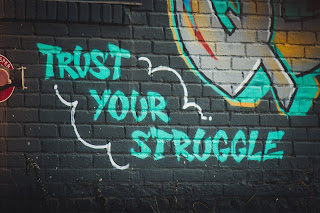Promoting Struggle
Our current generation of students need that confidence. “Zoomers” or “iGen” (born approximately 1995- 2012, currently 13-27 years old) are dominated by safety concerns and intimidated by risk taking. These are not students who like to “take a shot” at something and struggle. They don’t mind hard work, but struggling brings up feelings of insecurity and fear. According to Jean Twenge, in her book iGen, “It takes more reassurance and trust to get them to actively participate in class.” When these students join the workforce Twenge says that “more young employees are more anxious and uncertain; they are eager to do a good job but are scared of making mistakes.” Her advice is “Give them careful instructions for tasks, and expect that they will need more guidance [than previous generations].”
With this student profile, introducing difficult tasks is choppy water to navigate. To serve our students well, we must incorporate struggle points into our teaching practices, but do so intentionally to create a classroom culture that is productive and supportive. Peg Grafwallner, instructional coach and reading specialist, calls this the “not-yet” classroom culture. She says “The not-yet approach is all about designing and creating an authentic classroom culture that encourages the process of learning while accepting that setbacks and obstacles are part of that process.” In an interview for the Stanford News, Jo Boaler, faculty in the Stanford Graduate School of Education says “If you aren’t struggling, you aren’t really learning. When we’re struggling and making mistakes, those are the very best times for our brains.” “When we embrace struggle, it’s freeing. It changes how we go about our work. We’re more persistent. We interact with each other differently. If you live just a single day with this perspective, you’ll feel it – particularly if things go wrong. It changes those moments pretty significantly” (Spector, 2019).
So don’t shy away from tough assignments and projects that make your students stretch, but do scaffold them carefully, and address the expected struggle directly. Communicate that “the purpose of this assignment is for you to struggle and feel confused while you invent your own process to address the problem.” Providing this information helps students maintain confidence and persist even when they are unsure (Winkelmes, Boye, & Tapp, 2019). When we encounter challenges and difficulties, we are forced to engage our problem-solving skills and push beyond our comfort zones. In that moment, we are able to identify our weaknesses and areas for improvement, and learn to adapt and develop new strategies that are crucial for success in any area of life. Struggle is not only a natural part of the learning journey but also a necessary one, so let’s not deny our students the best journey possible.
References:
Dweck, C. S. (2006). Mindset: The new psychology of success. Random House.
Grafwallner, P. (2022, October 18). Making sure students' struggles are productive. Edutopia. Retrieved February 28, 2023, from https://www.edutopia.org/article/making-sure-students-struggles-are-productive/
Spector, C. (2019, September 27). 'embrace the struggle,' says Stanford Education professor. Stanford News. Retrieved February 28, 2023, from https://news.stanford.edu/2019/09/30/embrace-struggle-education-professor-challenges-common-beliefs-teaching-learning/
Twenge, J. (2017). iGen: Why Today’s Super-Connected Kids Are Growing Up Less Rebellious, More Tolerant, Less Happy–and Completely Unprepared for Adulthood. Atria Books.
VanLehn, K., Siler, S., Murray, C., Yamauchi, T., & Baggett, W. B. (2003). Why do only some events cause learning during human tutoring? Cognition and Instruction, 21(3), 209-249.
Winkelmes, M.-A., Boye, A., & Tapp, S. (2019). Transparent Design in Higher Education Teaching and Leadership : A Guide to Implementing the Transparency Framework Institution-Wide to Improve Learning and Retention: Vol. First edition. Stylus Publishing.

Comments
Post a Comment